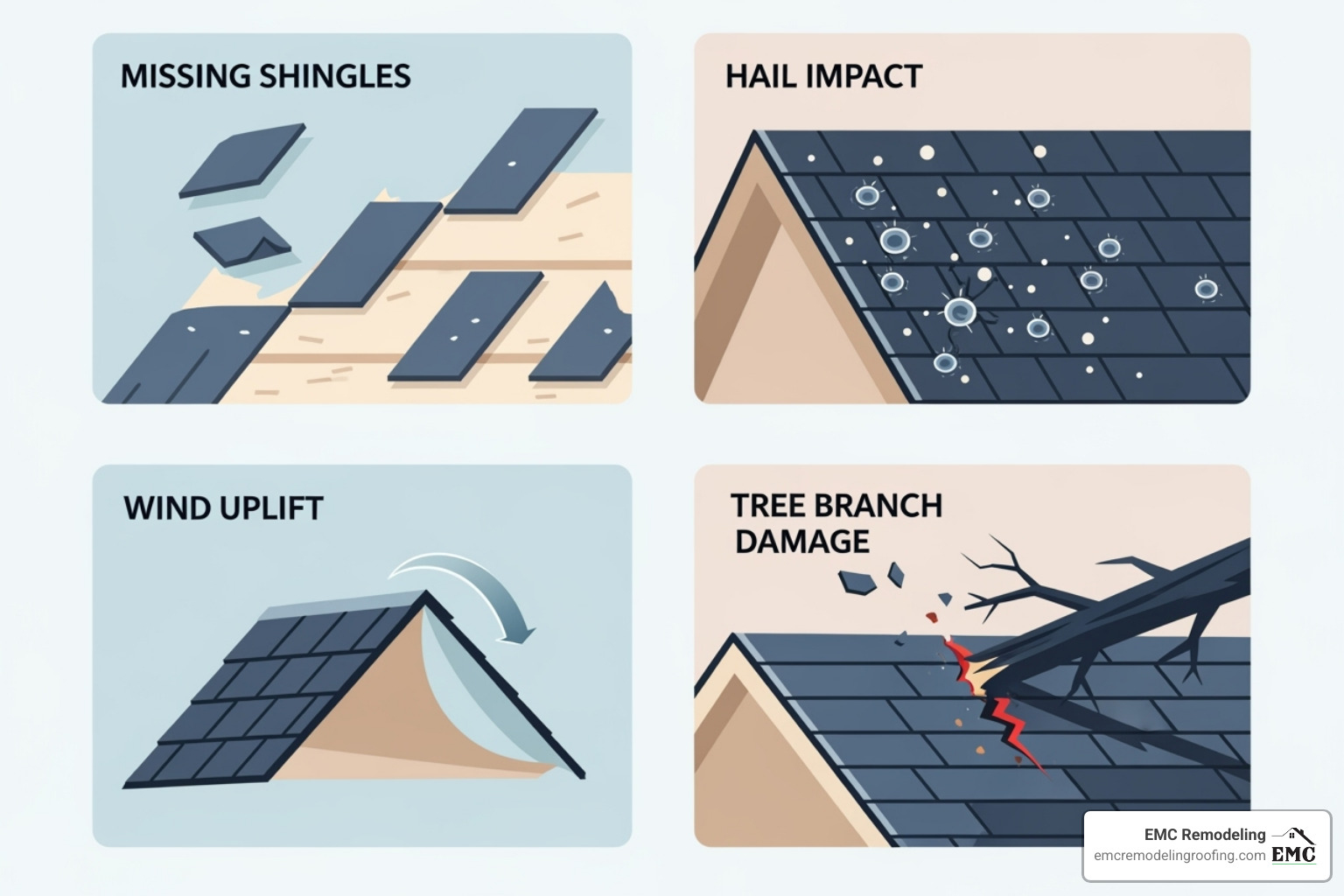Why Understanding Residential Roof Storm Damage Matters Now
Residential roof storm damage is a common and costly emergency for homeowners. When severe weather hits Central Texas, a swift response can prevent a simple repair from escalating into a total roof replacement. In 2024 alone, severe weather caused over $9 billion in insured losses nationwide, underscoring the financial stakes.
Immediate Steps After Storm Damage:
- Prioritize safety: Never climb on a wet or damaged roof.
- Document everything: Take photos and videos of all visible damage.
- Stop water intrusion: Use buckets to catch leaks and move valuables.
- Call professionals: Contact a licensed roofing contractor for an emergency assessment.
- Notify your insurer: File a claim within your policy’s timeframe.
This guide covers every phase of managing storm damage, from the first 24 hours through insurance claims and preventative measures. You’ll learn to identify damage, decide between repair and replacement, and protect your home from future storms.
The cost of inaction is steep. A minor leak can lead to mold, structural damage, and repairs costing thousands. While the average roof repair costs between $379 and $1,755, neglected damage can escalate to a full replacement costing $7,500 or more.
I’m Matthew Runyon, President of EMC Remodeling & Roofing. With 15 years of experience, I’ve guided countless Central Texas homeowners through residential roof storm damage recovery. Our family-owned company holds an A+ Better Business Bureau rating by providing honest assessments and quality repairs.
Whether you’re facing missing shingles or hidden water stains, this handbook provides the knowledge to protect your home. For immediate help, our 24/7 emergency services team is always ready.
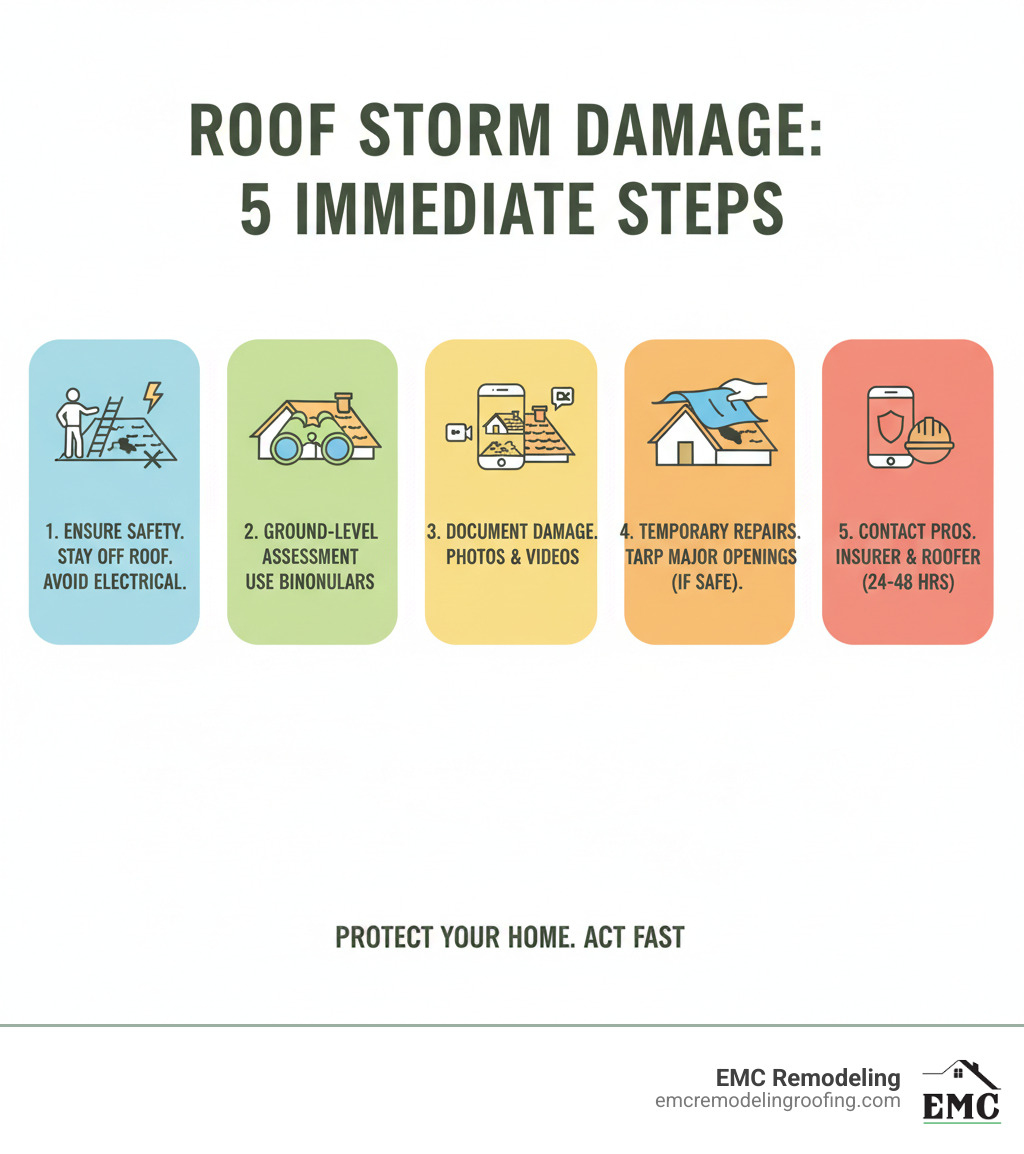
Key terms for residential roof storm damage:
First 24 Hours: Your Immediate Post-Storm Action Plan
The first 24 hours after a storm are critical for your family’s safety and protecting your home from further harm. Here is your step-by-step action plan.

Safety First: Post-Storm Precautions
Before assessing damage, ensure the area is safe. Residential roof storm damage can create unseen hazards.
- Downed Power Lines: Assume any downed lines are live. Stay at least 30 feet away and report them to your utility company immediately.
- Structural Stability: Before entering your home, look for leaning walls, sagging ceilings, or foundation cracks. If you see any warning signs, evacuate and call for help.
- Roof Access: Never climb onto a wet or damaged roof. Gale-force winds (39-54 mph) can compromise stability, and wet shingles are extremely slippery. It’s a risk not worth taking.
- Gas Leaks: If you smell gas, open windows as you exit and call the gas company from a safe distance.
- Debris: Wear sturdy, non-slip shoes to protect against nails, glass, and other sharp debris in your yard.
For more safety protocols, see our Emergency Roof Repair Complete Guide.
Initial Damage Assessment from the Ground
Once the area is safe, conduct a preliminary inspection from the ground. This helps identify obvious issues and determine if you need immediate professional help.
- Walk the perimeter of your property, viewing the roof from multiple angles.
- Look for missing or torn shingles in your yard, a clear sign of wind damage.
- Examine gutters, downspouts, and vents for dents, which indicate hail impact.
- Use binoculars for a closer, safe inspection of shingles. Look for curling, cracking, or granule loss, which appears as dark “bald spots” on asphalt shingles.
This ground-level assessment only reveals surface-level issues. Many types of residential roof storm damage require a trained eye to identify.
Emergency Mitigation: Stopping Further Damage
If you spot active leaks or major damage, act quickly to prevent secondary issues like mold and structural rot.
- Place buckets under active leaks to protect your floors.
- Move furniture, electronics, and valuables away from affected areas.
- Tarping: Covering large holes with a tarp can prevent water intrusion, but only attempt this if it can be done safely from a low, stable position. Do not risk climbing a steep or wet roof.
The most effective solution is to call EMC Remodeling’s 24/7 emergency services at (254) 265-6163. Our team provides professional emergency tarping and temporary repairs with the proper safety equipment. An exposed roof deck allows water to seep into your home’s structure, turning a manageable repair into a major reconstruction project. Don’t wait—the first 24 hours determine the course of your recovery.
Decoding the Damage: Identifying Types of Residential Roof Storm Damage
Central Texas weather is unpredictable. Understanding the specific signs of residential roof storm damage helps you assess the urgency of the situation.
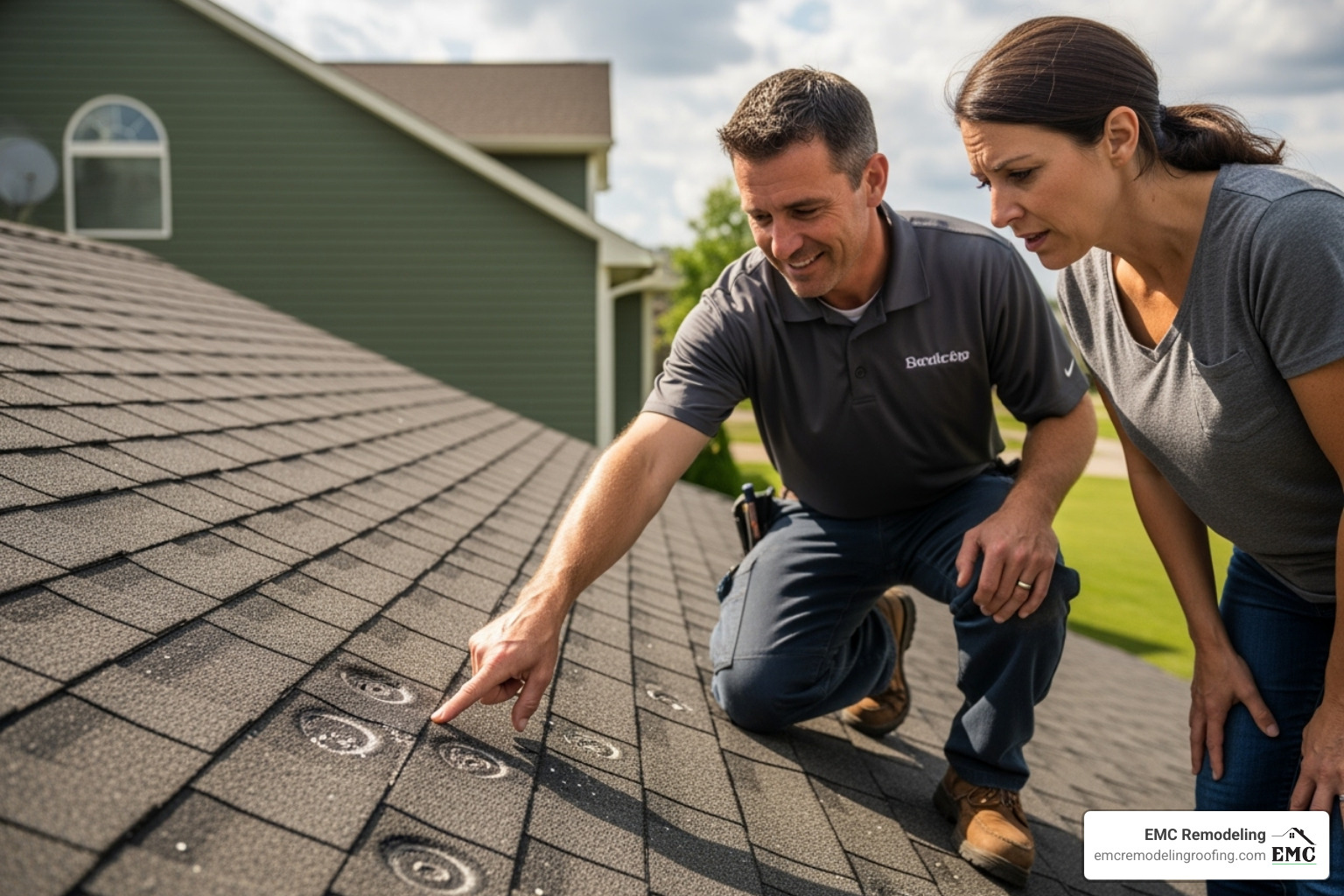
Identifying Wind Damage
Wind can lift, tear, and strip roofing materials, exposing your home to the elements. Common signs of wind damage include:
- Missing, curled, or creased shingles: High winds can get underneath shingles, bending them to the point of breaking or tearing them off completely.
- Loose or damaged flashing: The metal seals around chimneys, vents, and skylights are often bent or pulled away by wind, creating an entry point for water.
- Granule loss: Wind-driven debris can scour the protective granules from shingles, leaving behind a “bald” pattern that accelerates aging.
- Debris impact: Flying objects like tree branches can leave dents, punctures, or holes in your roof.
In severe cases, such as with Hurricane-force winds (74 mph or greater), entire sections of roofing can be lifted away.
Spotting Hail Damage
Hailstorms can pulverize a roof in minutes. To identify hail damage, look for:
- Dents on metal components: Gutters, vents, and flashing will show visible dents and pockmarks.
- Bruising on shingles: On asphalt shingles, hail impacts knock off the protective granules, leaving dark, round bruises.
- Random pattern of damage: Unlike wind damage, hail leaves a scattered, polka-dot pattern of impacts across the roof surface.
- Cracked or shattered tiles: Brittle materials like slate or tile are prone to cracking under hail impact.
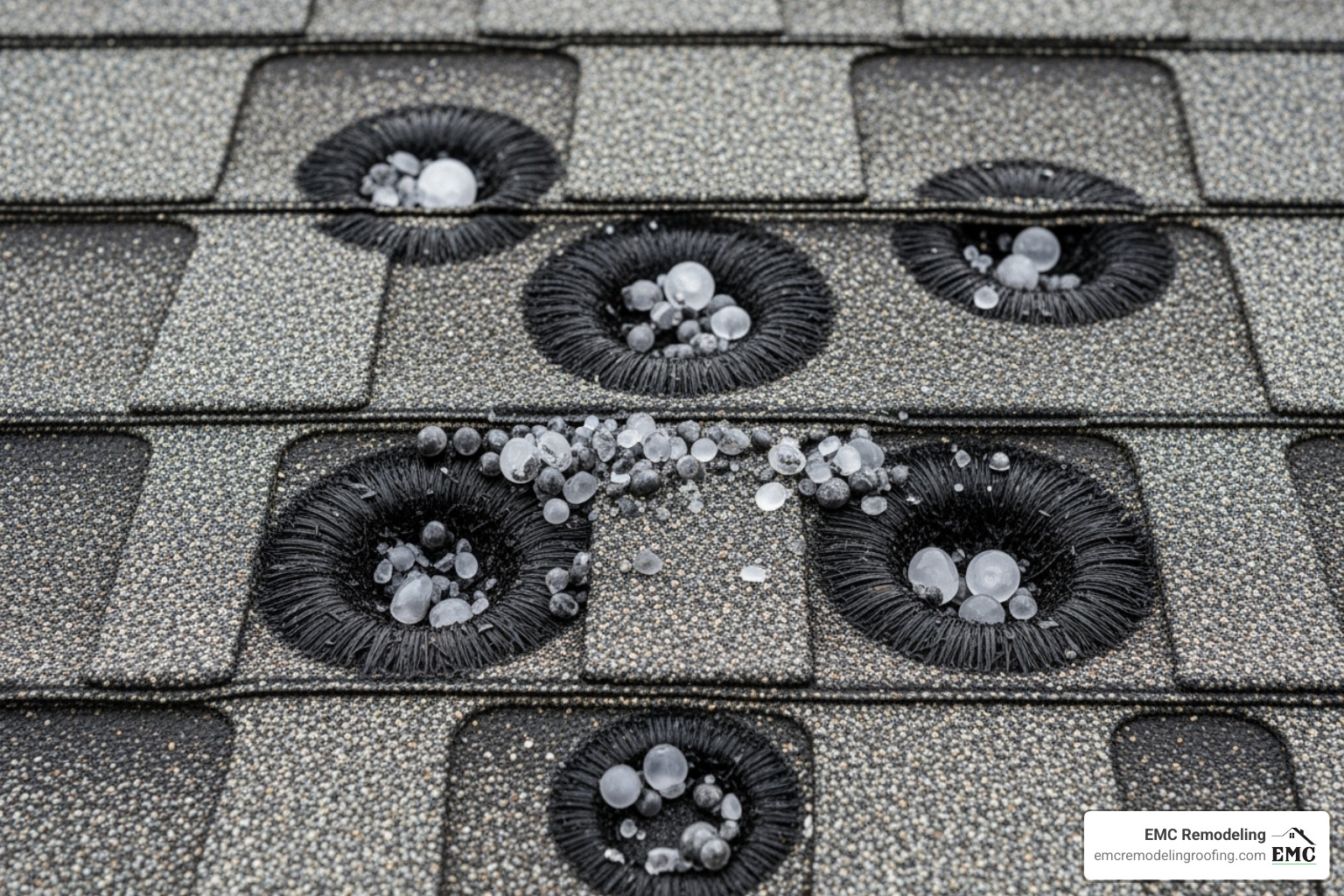
Hail damage can be subtle and may compromise a shingle’s integrity without being obvious from the ground, leading to future leaks. A professional Hail Damage Roof Repair inspection is essential to catch hidden issues.
Uncovering Hidden Water Damage and Leaks
Water damage often goes unnoticed until it becomes a major problem. Look for these interior signs of a leak:
- Attic issues: Check your attic for damp insulation or dark water stains on the wood decking, especially around vents and chimneys.
- Ceiling and wall stains: Discoloration, peeling paint, or bubbling drywall are clear indicators that water has penetrated your roof.
- Musty odors: A persistent musty smell in upper rooms often signals hidden mold or mildew growth from a slow leak.
- Clogged gutters: When gutters overflow, water can back up under the roofline and cause interior leaks.
Ignoring these signs allows a small leak to become widespread mold, rotted wood, and structural damage. An Attic Leak Repair specialist can find the source and prevent further costly damage.
Navigating the Aftermath: Insurance Claims and Professional Repair
Dealing with insurance claims after finding residential roof storm damage can be daunting. With proper documentation and professional support, the process is manageable.
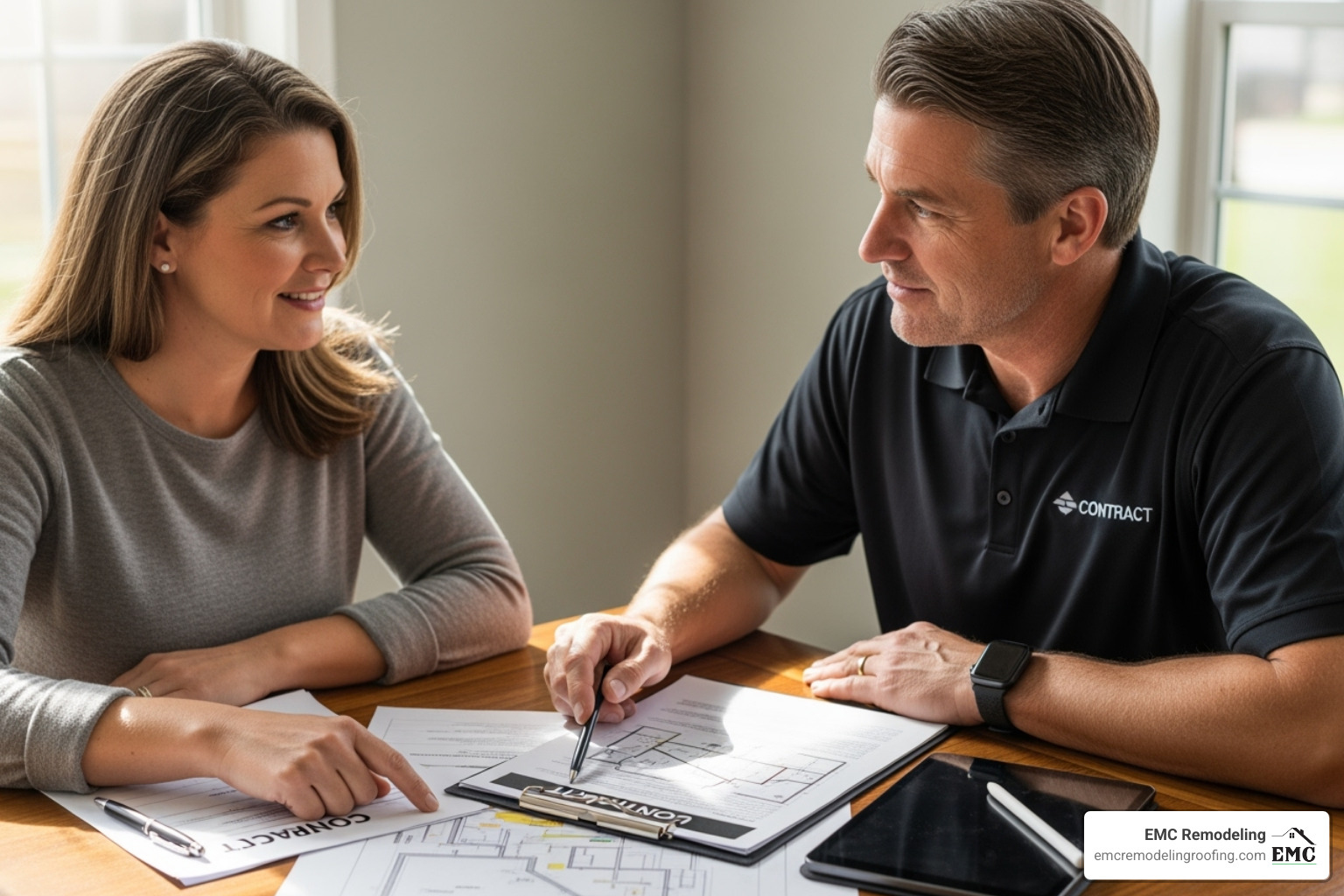
Documenting Residential Roof Storm Damage for Insurance
Thorough documentation is the foundation of a successful insurance claim. The more evidence you provide, the smoother the process will be.
- Take comprehensive photos and videos of all damage from multiple angles. Include close-ups of specific issues and wide shots of the entire roof.
- Photograph all interior damage, such as water-stained ceilings, wet insulation, or mold.
- Create a written log with the date and time of the storm and a description of the damage.
- Save all receipts for temporary repairs and emergency supplies, as these are often reimbursable.
- Document non-roof damage to gutters, siding, windows, or fences from the same storm.
The Insurance Claim Process Explained
Filing a claim follows a structured process. Understanding the steps helps you advocate for your home effectively.
- Contact your insurer immediately to report the damage. You’ll receive a claim number and be assigned an adjuster.
- Schedule the adjuster’s visit and be present for the inspection. Point out all the damage you have documented.
- Have your experienced roofing company present during the adjuster’s inspection. A roofing specialist can identify subtle damage that an adjuster might miss and ensure the assessment is accurate.
- Review the adjuster’s report carefully, comparing it against your documentation and your contractor’s assessment. Question any discrepancies.
- Understand your policy, including your deductible, depreciation clauses, and exclusions. Most policies cover storm damage but not gradual wear and tear.
For general disaster assistance, visit disasterassistance.gov or fema.gov/disaster.
Why You Need a Storm Damage Specialist
While some repairs seem minor, residential roof storm damage requires professional expertise.
- Accurate Assessment: A qualified contractor distinguishes between storm damage and pre-existing wear, which is critical for insurance claims.
- Correct Scope of Work: We advocate for a scope of work that fully restores your roof’s integrity, not just what an insurer’s initial estimate covers.
- Code Compliance: Our expertise ensures all repairs meet or exceed local Central Texas building codes, protecting you from future liability.
- Warranties: Professional repairs include both manufacturer warranties on materials and workmanship warranties on installation, giving you long-term peace of mind.
Beware of “storm chasers”—out-of-state contractors who offer low prices but often deliver substandard work with no warranty. Always choose a reputable, local company. Our Finding a Roofing Contractor guide can help you select the right professional.
For immediate assessment, call us at (254) 265-6163 or visit our storm damage repair page.
Repair or Replace? Making the Right Call for Your Damaged Roof
After a storm, the big question is whether to repair or replace your roof. Understanding the key factors will help you make the best decision for your home and budget.
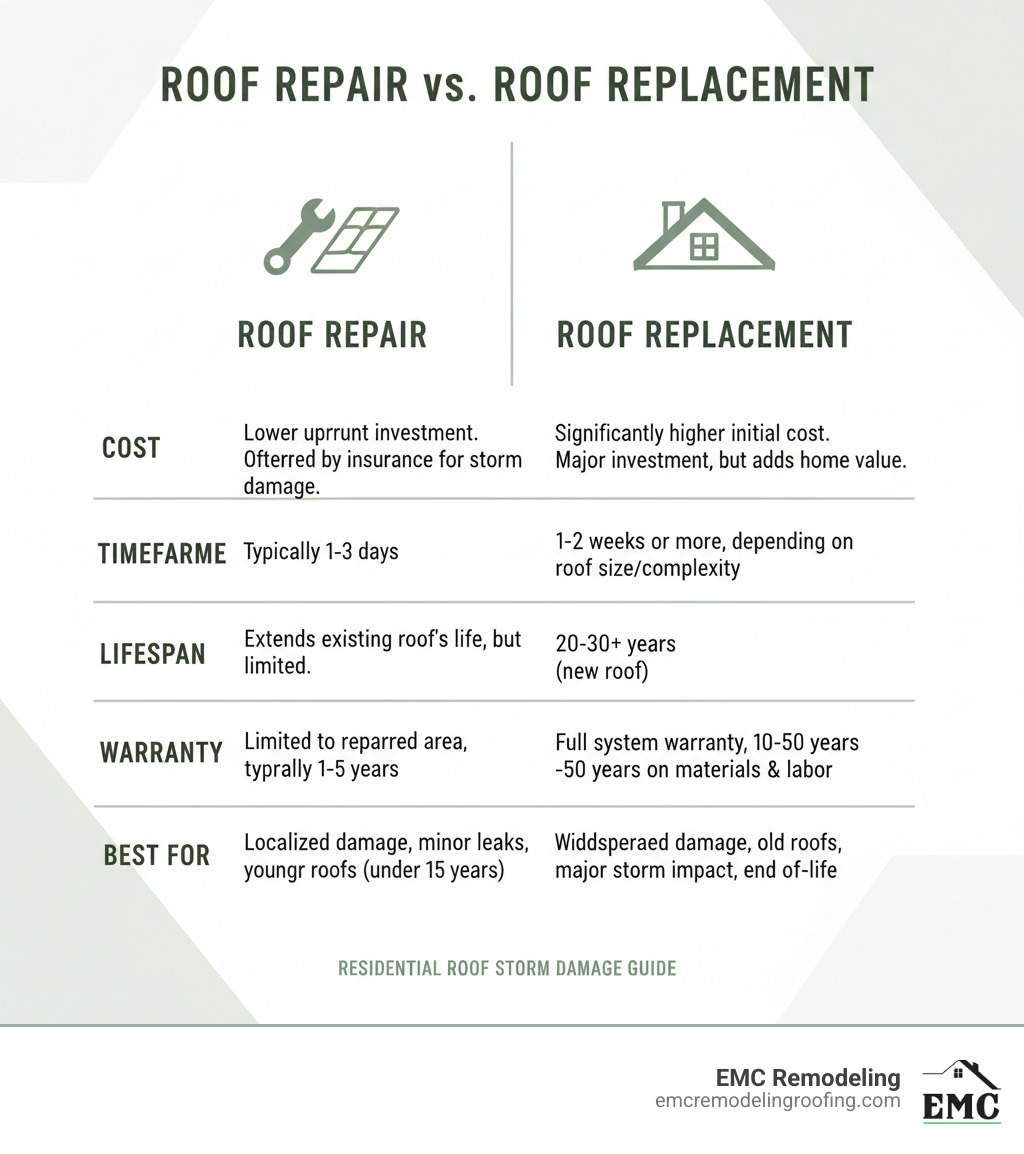
When is a Roof Repair Service Enough?
A targeted repair is often sufficient and more budget-friendly, with costs typically ranging from $379 to $1,755. A repair makes sense when:
- Damage is localized: If the residential roof storm damage is confined to a small area (less than 30% of the roof surface), a repair is usually the most logical choice.
- Your roof is young: A roof that is less than 10-15 years old has significant life remaining, making a quality repair a sound investment.
- The underlying deck is intact: If the roof deck is structurally sound, replacing only the damaged shingles is effective.
- Shingles can be matched: A good cosmetic match is possible, preserving your home’s curb appeal.
Signs You Need a Full Roof Replacement
Sometimes, a repair is not enough. A full replacement is a larger investment but is often the smarter long-term solution in certain situations.
- Widespread damage: When damage covers multiple slopes or a large percentage of the roof, the cost of multiple repairs can approach that of a replacement.
- Your roof is old: If your asphalt shingle roof is nearing the end of its 15-25 year lifespan, even moderate damage warrants a full replacement.
- Recurring problems: If you’ve had multiple repairs in recent years, it indicates the entire roofing system is failing, and patches are no longer a viable solution.
- Structural damage: If the storm has compromised the roof deck, a replacement is almost always necessary to ensure your home’s safety.
For a transparent assessment, get a Roof Replacement Estimate from our team.
The Long-Term Costs of Neglecting Residential Roof Storm Damage
Ignoring even minor residential roof storm damage can lead to a cascade of expensive problems. Procrastination is your enemy.
- Mold and Mildew: A small leak creates a breeding ground for mold in your attic and walls, posing health risks and requiring costly remediation.
- Structural Rot: Water intrusion causes wood rot in the roof deck, rafters, and joists, compromising your home’s structural integrity and leading to sagging or potential collapse.
- Higher Energy Bills: Wet attic insulation loses its effectiveness, forcing your HVAC system to work harder and driving up utility costs.
- Insurance Claim Issues: Insurers may deny claims for secondary damage (like mold) if you failed to address the initial storm damage promptly.
- Decreased Home Value: A damaged roof significantly reduces your home’s market value and curb appeal.
Acting quickly is not just about fixing a leak; it’s about preventing catastrophic failure. A prompt Roof and Attic Inspection can save you thousands in the long run.
Fortifying Your Home: Proactive Measures to Prevent Future Storm Damage
You can’t stop storms, but you can prepare your roof to withstand them. Proactive measures can dramatically reduce residential roof storm damage and provide peace of mind.
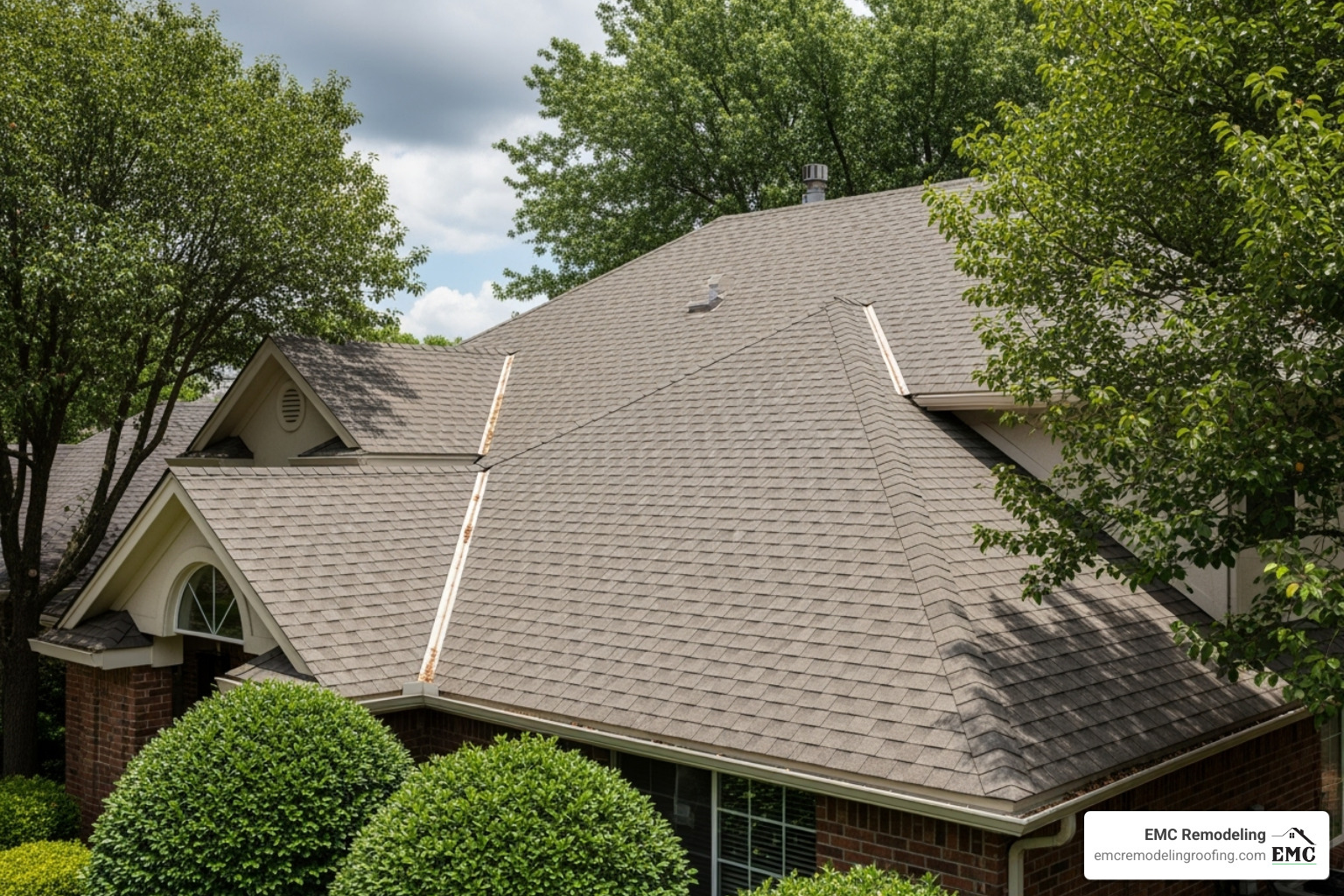
Routine Inspections and Maintenance
Regular check-ups are essential for catching small problems before they become storm-related disasters.
- Schedule annual professional inspections: A roof and attic inspection before storm season allows a professional to spot vulnerabilities like loose shingles, cracked seals, or compromised flashing.
- Perform DIY checks: Between professional visits, look for and seal loose flashing or exposed nail heads. Replace cracked rubber boots around vent pipes, as these degrade over time.
- Ensure proper attic ventilation: Good airflow helps regulate temperature and moisture, extending the life of your shingles from the inside out.
- Address minor issues promptly: A few loose shingles can be torn off in a storm, leading to major leaks. A timely Roof Repair Service prevents this escalation.
Material Upgrades and Gutter Care
Smart material choices and diligent maintenance provide a powerful defense against severe weather.
- Upgrade to impact-resistant shingles: When replacing your roof, consider Class 4 impact-resistant shingles. They are engineered to withstand hail and can earn you a significant discount (often 20% or more) on your homeowner’s insurance.
- Maintain your gutters: Clean, securely fastened gutters are crucial for proper water drainage. Clogged gutters cause water to back up under the roofline, leading to rot and leaks. Clean them twice a year, especially in the spring and fall.
- Trim overhanging tree branches: Keep branches at least six feet from your roof to prevent damage from falling limbs and reduce debris in your gutters.
- Secure outdoor items: Before a storm, secure patio furniture, grills, and decorations that could become wind-borne projectiles.
By combining regular maintenance with strategic upgrades, you fortify your home against Central Texas weather. For guidance on making your roof storm-ready, the team at EMC Remodeling is here to help.
Conclusion
When a storm passes, residential roof storm damage is manageable with the right approach. Prioritize safety, document the damage, take immediate steps to mitigate further harm, and call professionals you can trust. Swift action protects your home’s value, your family’s safety, and your peace of mind.
At EMC Remodeling, we are more than a roofing company; we are your neighbors. As a family-operated business based in Temple, TX, we have built our A+ Better Business Bureau reputation by serving communities across Central Texas—from Lago Vista and Cedar Park to Killeen and Belton. We understand that storm damage is personal, which is why we offer 24/7 emergency support with direct owner involvement.
We’ve seen the stress storm damage causes and the relief that comes from having a trusted partner. We show up when our neighbors need us and do the job right the first time. Don’t wait for a small leak to become a structural crisis or steer a complex insurance claim alone.
For a comprehensive damage assessment and expert guidance, reach out to our storm damage repair team online. We will walk you through every step, from the emergency tarp to the final shingle, ensuring your home is ready for whatever comes next. Your home deserves expert care, and you deserve to feel secure.
